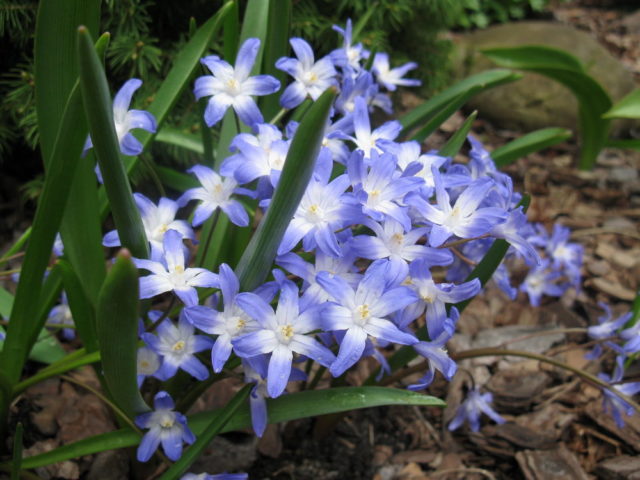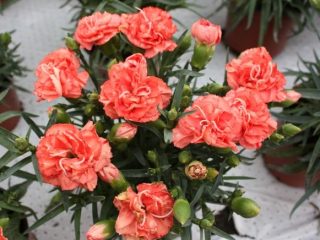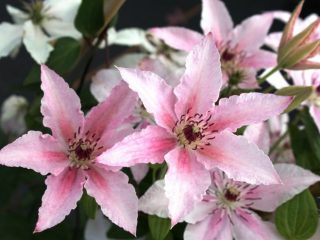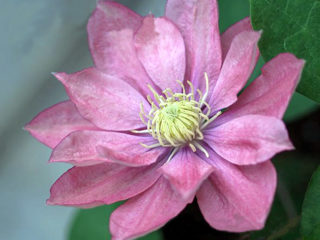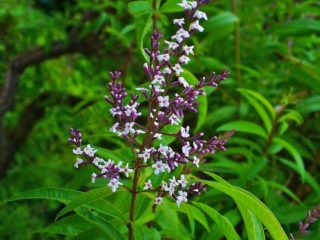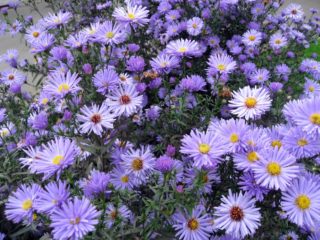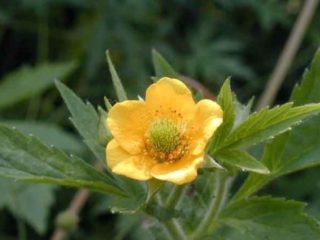Content
Planting and caring for chionodox in the open field is possible even for novice gardeners, since the perennial is unpretentious. It appears simultaneously with the snowdrop and snowdrop, when the snow has not completely melted yet. The tenderness and sophistication of this flower has found application in landscape design.
History of appearance
The name Chionodoxa (Latin Chionodoxa) comes from the Greek words "chion" and "doxa", which means "snow" and "pride". This is due to the fact that the plant appears still under the snow. He also has popular names - a snowman, a snowy beauty.
In Russian-language literature, Scylla Lucilia (Scilla luciliae) is often called chionodox. This bulbous perennial was named after Lucille, the wife of the botanist Pierre Edmond Boissier.
Breeders work with different plant species to create hybrids. A whole series of them was created by V. Khondyrev.
Description and characteristics
Chionodoxes belong to the genus Scylla and the Liliaceae family. They are found naturally in Asia Minor and Crete. Bulbous plant characteristics:
- height 0.1-0.2 cm;
- peduncle length up to 0.2 m;
- annual roots;
- basal leaf plates (1 pair) 8-12 cm long, with a dark green color, are grooved and broadly lanceolate, appear simultaneously with peduncles;
- brushes with 2-3 buds are formed at the ends of the peduncles;
- flowers are bell-shaped and have 6 petals, diameter 2.5-4 cm;
- inflorescence racemose and loose, flowers can be single;
- the leaves of the wide-spread, broadly bell-shaped or stellate perianth are fused at the base, slightly laid back;
- the fruit of chionodoxa is a fleshy capsule with black, rounded seeds that have a juicy appendage;
- the bulbs have an ovoid shape, length 2-3 cm, width 1.5 cm, light scaly surface, 2 annual cycles.
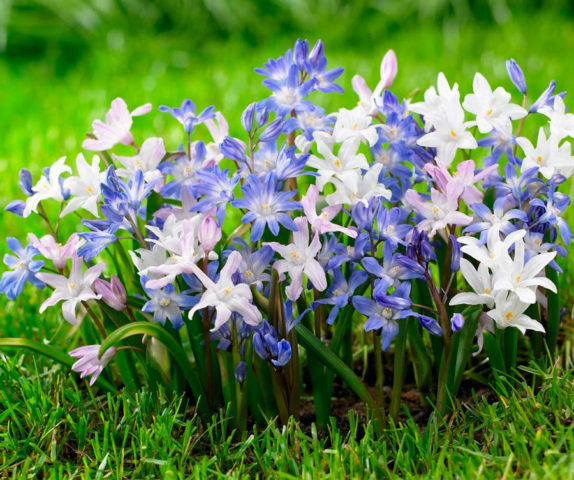
Chionodoxa is a myrmecochoric plant - ants eat and distribute its seeds
When and how it blooms
Chionodoxa is an early perennial. Its bloom usually begins in April, when it gets warmer outside. For some varieties, the dates are later and fall in May.
The color of the plant is different, but all shades are calm. The flowers are white, blue, blue, pink, lilac, purple.
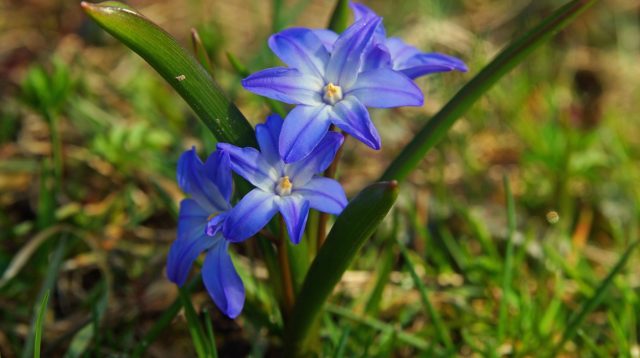
The color of chionodoxa flowers is uneven - there is a light spot in the center, the shade becomes darker and richer towards the tips of the petals
Flowering lasts only 2-3 weeks. The growing season ends in early summer with the death of the aerial part of the plant.
Types and varieties
There are few varieties of chionodox, but the perennial crosses well with other plants. This made it possible to create interesting varieties and hybrids. Only half of the species are used in horticulture. The variety of species will make it possible to be convinced of the photo of chionodoxa of different varieties.
Chionodoxa whitish
The whitish chionodoxa (Chionodoxa albescens), contrary to the name, has a pale pink flowering with a lilac tint. It grows up to 0.1-0.15 m. On one peduncle there can be 1-3 buds.
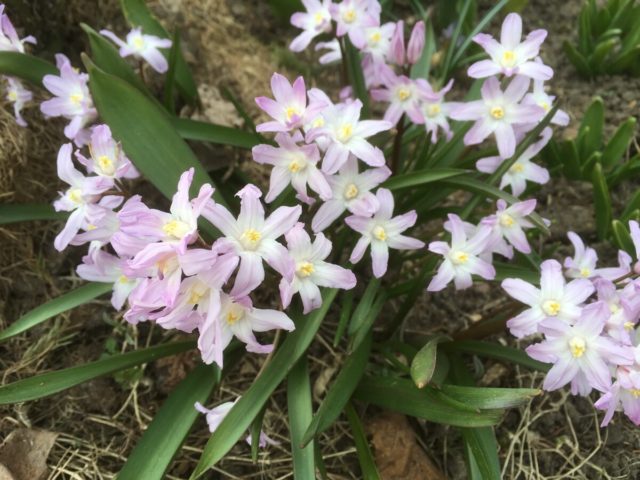
Chionodoxa has whitish small flowers with a diameter of 1 cm
Chionodox Forbes
Chionodoxa forbesii, or Tmoluza (Chionodoxa tmolusi), can be found naturally in southern Turkey (Aladag mountain range). The plant prefers a height of up to 2.5 km. It has been cultivated since 1976. Characteristics:
- height up to 0.25 m;
- the peduncle is not higher than 0.15 m, it has up to 15 buds;
- in vertical loose inflorescences-brushes, the width is less than the length;
- flowers up to 3.5 cm in diameter, blue color, with a white spot surrounding the peephole;
- some varieties are white or pink;
- the plant does not set seeds, propagates only by bulbs.
The crossing of this species with the two-leaved proleskoy (scylla) led to the creation of a new hybrid. They call him Chionoscylla. The height of such a plant is up to 0.1 m, the inflorescences are dense, the flowers are small blue and star-shaped.
Blue Giant
Chionodox Forbes Blue Giant has an intense blue color. This variety was named the blue giant because of its color and large size for its type. It grows up to 0.2 m, the size of the bulbs is 5 cm.
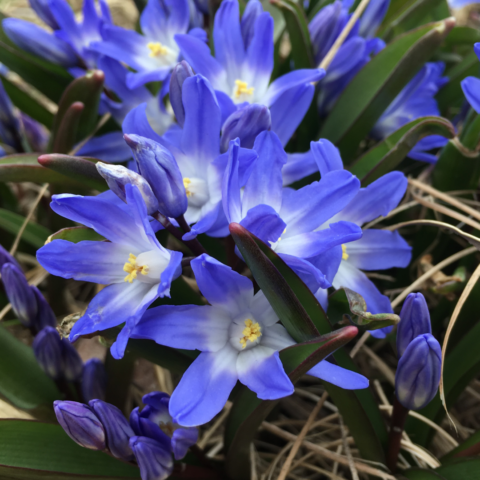
The flowering of the Blue Giant variety, depending on the region, occurs in March-May.
Pink Giant
The Pink Giant variety attracts with its pink-lavender color of flowers. Plant height reaches 15 cm. They have dark stems and rare narrow leaves. Up to 10 flowers with a white core are formed.

Pink Giant blooms in March-April.
Chionodox Lucilia
In nature, Chionodoxa luciliae can be found in the mountainous regions of Asia Minor. The plant has been cultivated since 1764. Main characteristics:
- height up to 0.2 m;
- peduncles up to 0.2 m, have up to 20 buds;
- flowers up to 3 cm in diameter, blue-blue color with a white core;
- the plant blooms in April-May;
- bulbs are round and small in size;
- flowering of garden forms of this fila can be white or pink.
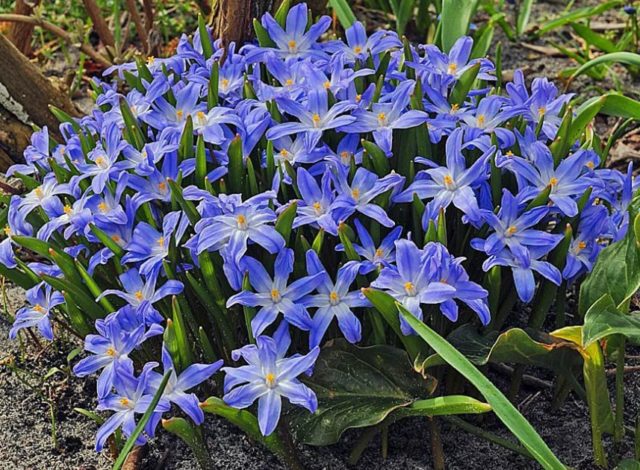
Chionodoxa Lucilia blooms for 3 weeks
Alba
Variety Alba (Alba) means snow-white color of flowers. Their diameter is up to 2.5 cm. The height of the plant is not more than 0.1-0.15 m. Inflorescences are racemose, each with 3-4 buds.
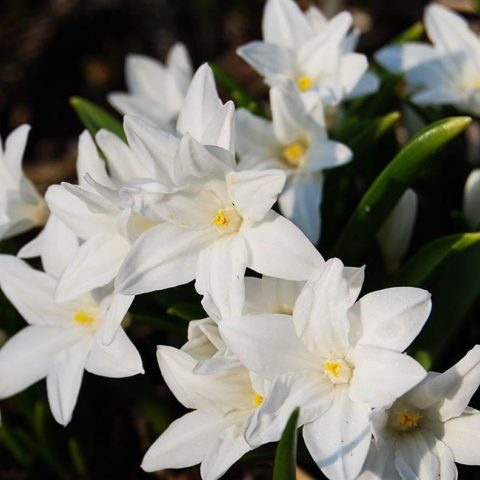
The Alba variety blooms in April-May for 1.5-2 weeks
Violet Beauty
Violet Beauty is a pink-purple bloom. It starts at the end of March. Plant height does not exceed 0.1-0.15 m.
Violet Beauty is a hybrid. On peduncles 4-5 buds are formed.
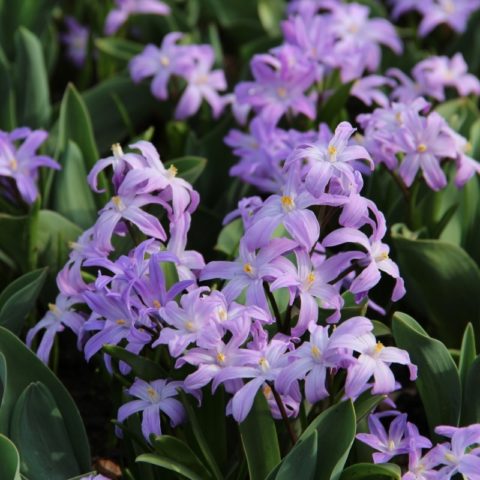
Violet Beauty feels good both in the sun and in partial shade
Rosea
Plants of the Rosea variety grow up to 0.2-0.25 m. Characteristics:
- peduncles have up to 15 buds;
- vertical loose inflorescences-brushes half-plant high;
- flowering in the middle lane occurs in April.
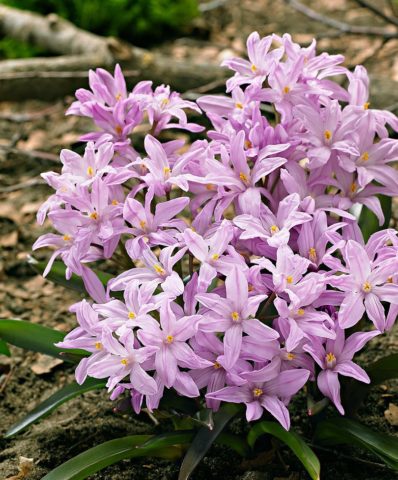
Rosea flowers 1-3.5 cm across
Chionodoxa giant
In some sources, the giant chionodoxa (Chionodoxa gigantea) is called not an independent species, but a synonym for the chionodoxa Lucilia. In its natural form, it is a plant of the alpine belt in the mountains of Asia Minor. It has been cultivated since 1878. Main characteristics:
- peduncles up to 0.1 m, each with 1-5 buds;
- basal leaves taper upward;
- bright blue perianths with a purple tint, the pharynx is lighter;
- flowering begins until mid-April;
- bulbs are dense and light, ovoid in shape, size up to 3 cm.
Chionodoxa Sardinian
The homeland of the Sardinian Chionodoxa (Chionodoxa sardensis) is the mountainous regions of Asia Minor. The perennial has been cultivated since 1885. The main parameters of the flower:
- the average height of peduncles is 0.1 m, each with up to 10 buds;
- the diameter of the flowers is 1.5-2 cm, the color is bright blue;
- cultivated varieties have white or pink colors;
- flowering lasts 3-3.5 weeks;
- ovoid bulbs, covered with brownish scales;
- the plant blooms 5-6 days after chionodoxa giant.
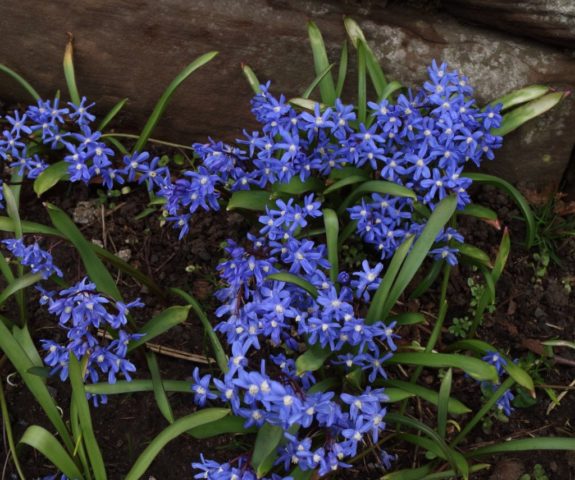
A distinctive feature of Chionodoxa Sardinian is the absence of a white spot in the pharynx
Chionodoxa Cretan
Chionodoxa cretica (Chionodoxa cretica) is also called dwarf (Chionodoxa nana). The first option is explained by the size of the plant, the second - by the habitat in nature, the subalpine belt of the mountains of Crete. This perennial is rarely cultivated. The characteristics are as follows:
- the height of the peduncles is 0.1-0.15 m, on each 1-5 buds;
- flower diameter up to 1 cm;
- perianths are blue.
Reproduction methods
Chionodox can be propagated vegetatively or by seed. It is easier to use the first option, that is, to separate the children from the parent plant; during the season, each bush forms them from 2 pieces.
For reproduction by bulbs, they must be dug out in the second half of July. Before planting, keep the collected material in a dark and dry place at a temperature of 15-17 ° C
Chionodoxa reproduces well by self-seeding, but ants can spread seeds throughout the site. Self-collection of the seed, which must be done before the bolls burst, will help to avoid this. It is convenient to wrap them with gauze in advance. Seedlings are grown from the harvested material, which are then transferred to open ground.
Planting and caring for Chionodox
Chionodoxes attract gardeners not only for their tenderness and early flowering, but also for their unpretentiousness. A perennial is easy to plant, caring for it should be comprehensive, but all the measures are simple.
Landing dates
Chionodox are usually planted with bulbs. It is recommended to do this at the very beginning of autumn, when root ridges are finally formed on the bottoms.
Site and soil preparation
Chionodoxes prefer open and well-lit areas where they bloom as early as possible. You can plant them near trees and shrubs, since in early spring there is still no foliage on them. In this case, flowering will begin later, but the decorative effect will last longer.
Optimal growing conditions:
- loose nutritious and moderately moist soil;
- the reaction of the soil is neutral or slightly alkaline;
- remoteness of groundwater;
- effectively adding forest land with rotted foliage and tree bark.
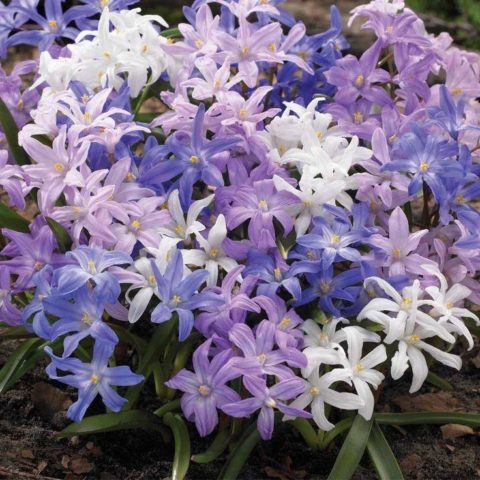
After planting chionodox, it is recommended to apply nitrogenous fertilizers
Landing
Chionodoxa is planted similarly to other bulbous crops. If the material is prepared independently, then immediately before placing it in a permanent place, the nest must be divided along the line of shares. Landing Algorithm:
- Dig up the selected area, get rid of weeds, loosen.
- Soak the bulbs in advance in a solution of potassium permanganate.
- Prepare indentations at intervals of 5-10 cm, depending on the size of the planting material.
- Place the bulbs in the wells. To deepen large specimens by 6-8 cm, smaller ones by 4-6 cm.
Follow-up care
It is difficult to find a more unpretentious flower than Chionodoxa. The first care for him is the following:
- watering if the spring is dry and there was little snow in winter;
- loosening the soil around the plants;
- weeding;
- mulching - dry peat, humus.
In the future, watering is needed only with prolonged drought. The water should be settled and not cold. Watering is needed abundant, it is done early in the morning, avoiding moisture on the flowers.
For the season, it is enough to feed the perennial once. Complex mineral fertilizers such as nitroammofoska are effective. They provide abundant and long-lasting flowering. If the product is granular, then evenly distribute it over the soil and slightly loosen it.
At the beginning of the flowering of chionodox, to stimulate it, you can feed the plant with organic matter.
Preparing for winter
When the flowering is over, you need to get rid of all the arrows. The foliage is left until completely wilted, then cut off.
Chionodoxa is characterized by high frost resistance.If the region has a mild climate, then the perennial does not need any shelter. You need to organize it if the flower grows in an open area. To do this, use fallen leaves or spruce branches. The plant is covered in late autumn.
Diseases and pests
Chionodox is resistant to many diseases, but unfavorable factors can provoke them. More often it is high humidity, soil flooding.
One of the problems is gray mold. The defeat leads to rotting of the bulbs. Outwardly, the disease manifests itself in slow development, poor flowering, yellowing and drying of the leaves. On the affected parts of the plant, first a dark and fluffy, then a gray powdery coating appears.
Bulbs affected by gray rot must be destroyed. For prophylaxis, plant residues are burned, and planting material is etched with fludioxonil preparations (fungicide) before storage.
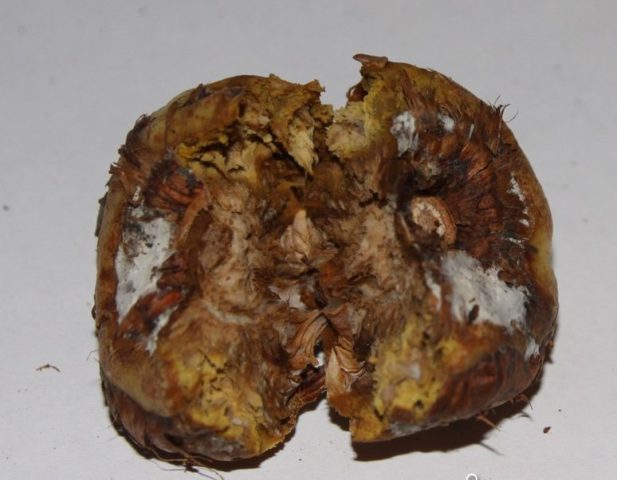
Gray rot spreads quickly, spores are carried by wind and moisture during watering and precipitation
Another fungal infection is fusarium. It manifests itself as dark spots on the foliage, followed by its blackening, drying and falling off. In an advanced stage, the bulb is affected. It is necessary to get rid of diseased plants, spray the rest with Fundazol (Benomil).
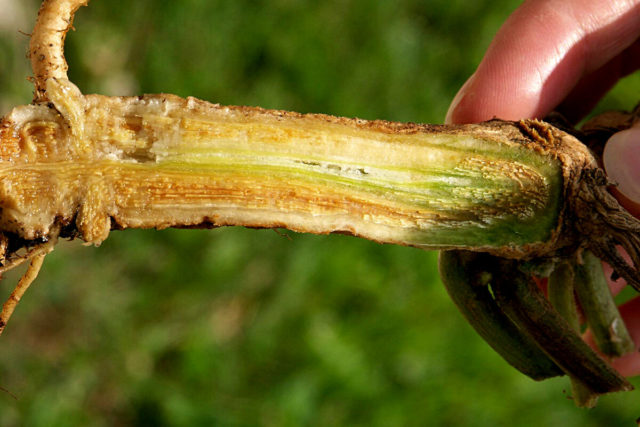
Risk factors for fusarium - temperature and humidity drops in air and soil, nutritional deficiencies
Of the fungal diseases, chionodox can be affected by septoria. On the leaves, it appears as dark spots with a red border and a light area inside. The affected areas turn yellow and dry, flowering suffers. Fungicides are used to fight the fungus.
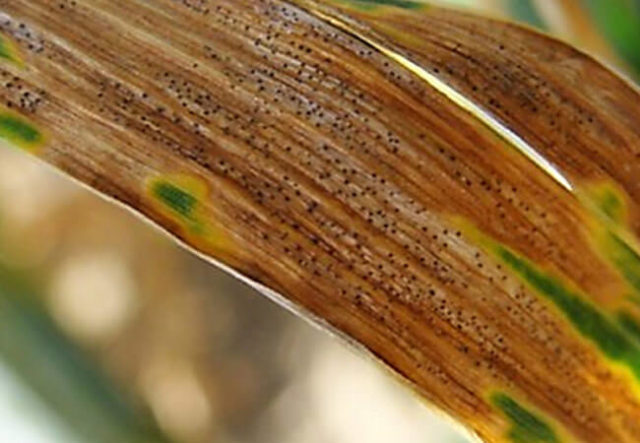
For the prevention of septoria, it is necessary to remove plant residues, spray the plantings with fungicides
Of the pests, the onion root mite is dangerous. Affected tubers quickly die and become unsuitable for reproduction. To fight the enemy, they use acaricides - Aktara, Aktellik, Akarin.
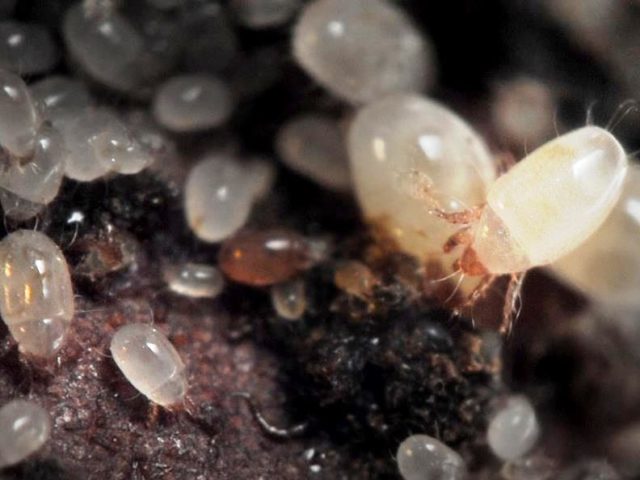
The onion mite has a whitish or yellowish color, the size is only 1 mm
Chionodox is also harmful to mice and moles. Plant bulbs are food for them. To combat rodents, poisons, mechanical traps, and scarers are used.

Moles, mice and other rodents are afraid of the blackroot plant, popularly called the rat rat race.
Chionodoxa flowers in landscape design
When using chionodox in landscape design, it is important to remember that in the summer, their aerial parts die off. The decorativeness of this plant is short-lived.
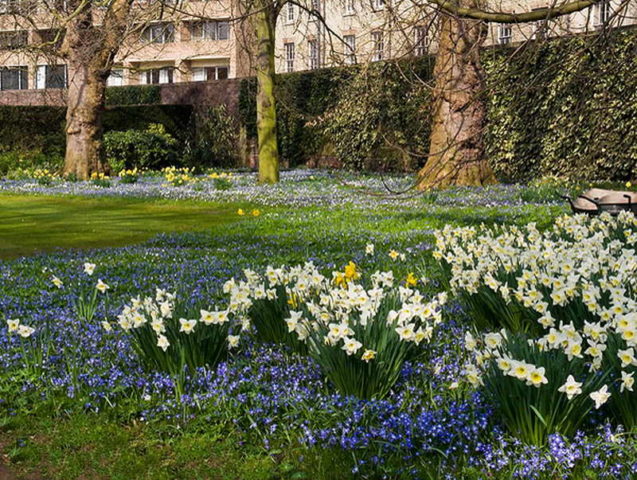
Chionodoxa fills the space under the trees well in the spring, revitalizes the lawn
This perennial should be combined with other early flowers: spring adonis (adonis), armeria, its flowering begins in late spring and lasts all summer, white flower, hyacinths, irises (undersized species), kandyk (erythronium), hellebore, primrose (primrose), liverwort (coppice), snowdrops.
Chionodoxes are stunted and unpretentious, which makes them a welcome guest in rockeries and rock gardens. These flowers feel great among stones and gravel bedding.

Chionodoxa is effective in planting in small groups
In a multi-stage design, chionodoxes are planted on the lower level. Other flowering plants and evergreen shrubs serve as a good background for them.
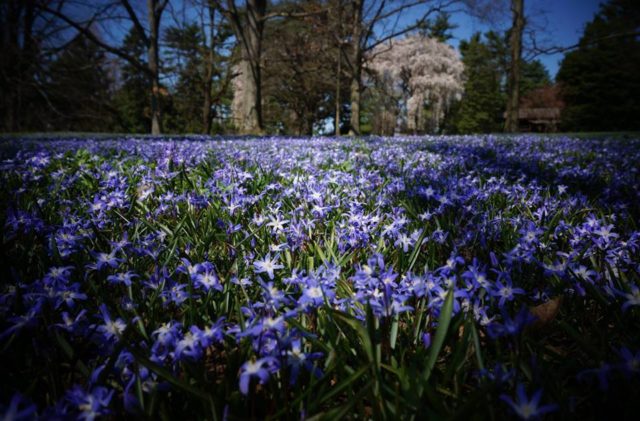
Chionodoxoy is good at filling empty spaces, creating a beautiful flowering carpet
This early perennial can be placed along curbs. It looks spectacular in linear landings.
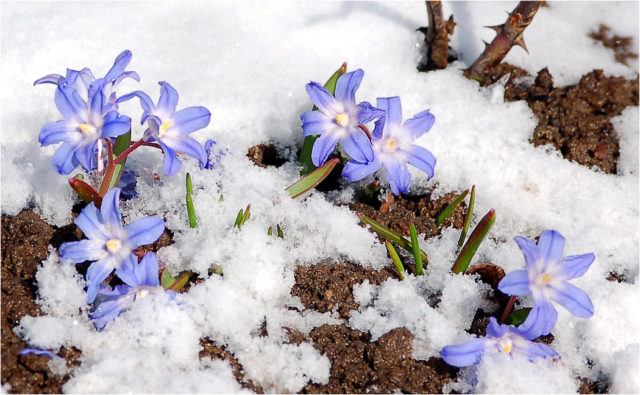
Melting snow is the perfect backdrop for Chionodox and a source of moisture it needs.
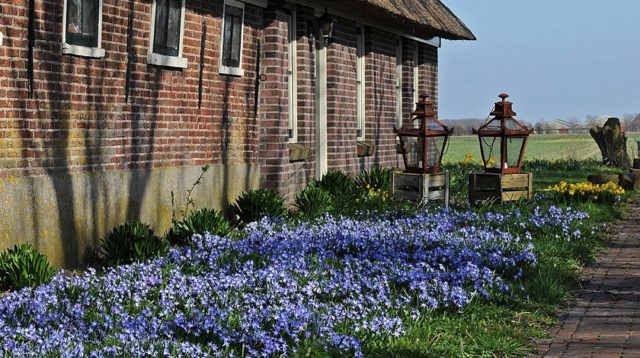
Chionodox planted outside the house enliven the view from the window
Recommendations
Chionodox is easy to grow. The following recommendations will help to activate its activity and increase its decorative effect:
- Effectively forcing chionodoxa for active development and abundant flowering.The plant looks good in pots and containers and can be grown in them.
- Drainage and good gas exchange can be ensured by introducing sand and gravel.
- Chionodoxa does not like lowlands. If the site is like this, then it is better to plant a perennial on a slope or make an artificial hill for it.
- The plant needs to be transplanted every 5-7 years, otherwise it will become smaller.
- You can improve the composition of heavy soil by introducing peat and sand - 1 bucket per 1 m².
Conclusion
Planting and caring for Chionodox outdoors is much easier compared to other garden plants. This perennial is unpretentious, one of the first to bloom, is not afraid of cold weather. It goes well with other colors and can be effectively used in landscape design.
